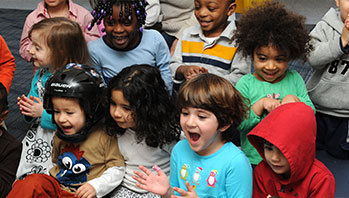MA Standards:
English Language Arts/Speaking and Listening/SL.PK.MA.1a: Observe and use appropriate ways of interacting in a group (e.g. taking turns in talking, listening to peers, waiting to speak until another person is finished talking, asking questions and waiting for an answer, gaining the floor in appropriate ways).
Head Start Outcomes:
Social Emotional Development/Self-Regulation: Follows simple rules, routines, and directions.
Language Development/Receptive Language: Attends to language during conversations, songs, stories, or other learning experiences.
PreK Learning Guidelines:
English Language Arts/Language 1: Observe and use appropriate ways of interacting in a group (taking turns in talking; listening to peers; waiting until someone is finished; asking questions and waiting for an answer; gaining the floor in appropriate ways).
English Language Arts/Reading and Literature 12: Listen to, recite, sing, and dramatize a variety of age-appropriate literature.
Greeting Song: “Where Is?” #17

© Commonwealth of Massachusetts, Department of Early Education and Care (Jennifer Waddell photographer). All rights reserved.
ELA Focus Skills: Name Recognition, Follow Directions, Phonological Awareness (Rhythm and Repetition)
Tell children you want the whole group to pretend they are plants in a garden and grow as they sing when they hear their name.
- Give each child a plant name, e.g., Tulip Tonya, Strawberry Sam, Carrot Kurt, etc.
- Then tell them you want them to crouch down into a ball, like a seed in the ground. Say, Today when I sing “Where Is?” I will call out your plant name and I want you to grow and open up like a plant as you sing “Here I am!”
- Demonstrate for children how to unfurl their leaves, grow tall and straight, and open up their petals (open your arms).
- When all “plants” have grown, sing “Where are our garden plants?” Have children respond with “Here we are!” Compliment the beautiful garden group.
Where Is?
(sung to the tune of “Where is Thumbkin?”)
(Educator:)
Where is <name/plant name of child>?
Where is <name/plant name of child>?
(Child stands up and sings:)
Here I am!
Here I am!
(Educator:)
How are you today, <name/plant name of child>?
How are you today, <name/plant name of child>?
(Child:)
Very well, thank you!
Very well, thank you!
(Educator:)
Please sit down.
Please sit down.
Social Emotional Tip: Changing procedures with greeting songs helps children build the ability to manage transitions and adapt to changes in routines and new situations.
